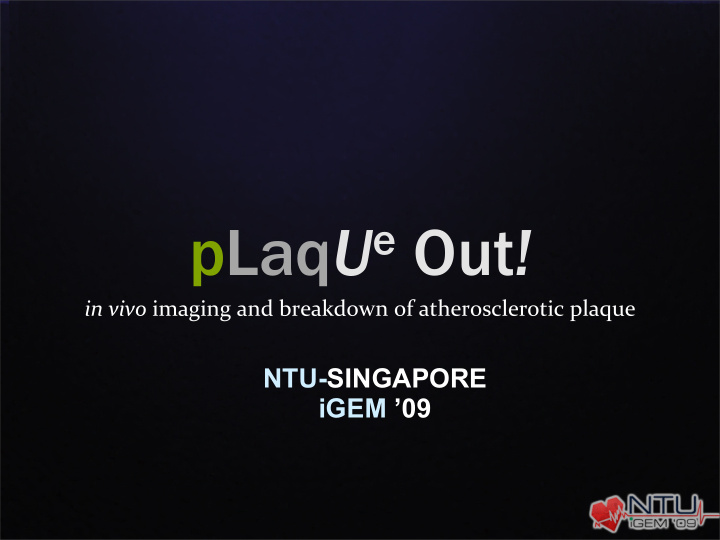



pLaq U e Out ! in vivo imaging and breakdown of atherosclerotic plaque NTU-SINGAPORE iGEM ’09
Atherosclerosis o Kills millions yearly o Hard to diagnose early o Medications don’t cure, only relieve symptoms o Major surgery as last resort o What if plaque breakdown Non-invasive is possible in vivo ? Painless
Anatomy of a plaque site Reduced lumen area means faster flow rate Abundant p-selectin expressed on damaged endothelium Blood [NO] levels fall drastically at plaque site Lipid core consists of cholesteryl esters Hard to diagnose
What if?
Engineering a solution o Detect falling levels of [NO]. o Identify the plaque site. o Break down the lipid core enzymatically o Bonus! Dilate the vessel locally with NO.
THE GOAL Sensing device is active in high [NO] . It actively represses Sensing the other constructs. device In the vicinity of plaque, [NO] falls . Release Catch-bond mechanism devices attaches system to site. Sensing device shuts down Dilation in low [NO] . device Release & Dilation devices activate .
Degradation device releases enzyme to Degrading enzyme attack lipid core. breaks down cholesterol esters in plaque. Imaging device Imaging releases an imaging protein in vivo . Degradation Dilation device Plaque site is visually identified .
Dilation device releases enzyme to produce NO after programmed delay. Sensing device Release devices As [NO] increases, Sensing device re-activates , Dilation shutting down system. device
Our Genetic Circuit
Prototype Specifications NO TetR Sensing device TetR IFP Imaging CHE Degradation LuxR-AHL NO Dilation device
Modeling Profile Simulink circuit representation for modeling
Time-variant model activity
pLaq U e Out ! Low [NO] Low [TetR] NO-sensing device Low [TetR] Cholesteryl esters degradation device Cholesteryl esterase Infrared imaging device Infrared fluorescent protein (IFP)
NO-sensing device : E. coli K12 genome PCR Conversion to a standard biobrick by synthesis NO-sensing pNO RBS TetR Term construct For enhanced TetR NO pNO activity *Tucker, N. P., B. D. Autreaux, et al. (2006). " Mechanism of transcriptional regulation by Escherichia coli nitric oxide sensor NorR. " Biochemical Society Transactions 34(1): 191 - 194.
NorR expressing construct 42 deg 37 deg 30 deg -ve C C C Ctrl Double digestion results. Length of system construct corresponds to expected size ~ 1750 bp J23119 B0034 NorR B0015
NO-sensing promoter (pNO) is ↑ Fluorescence with ↑ [SNP] Response of pNO to increasing [SNP] GFP Fluorescence (AU) Test Construct [SNP] (mM) Time (min) pNO RBS GFP Term
pLaq U e Out ! Low [NO] Low [TetR] NO-sensing device Low [TetR] Cholesteryl esters degradation device Cholesteryl esterase Infrared imaging device Infrared fluorescent protein (IFP)
Cholesteryl esters degradation device produces cholesteryl esterase in absence of Low [TetR] CHE LuxI
Cholesteryl esters degradation device breaks down cholesteryl esters Extent of cholesteryl esters degradation with controls Cholesteryl esters Fluorescence (AU) degraded!! Transformed Cells w Test Construct induction Tansformed Cells w/o induction CHE Untransformed Cells Background Time (min) pLacI RBS CHE Term
pLaq U e Out ! Low [NO] Low [TetR] NO-sensing device Low [TetR] Cholesteryl esters degradation device Cholesteryl esterase Infrared imaging device Infrared fluorescent protein (IFP)
In vivo IR imaging device: IFP is a novel reporter protein • Discovered by Roger Tsien’s lab at UCSD. • Excitation (684 nm) and emission (708nm) do not interfere with blood constituents • Biliverdin is essential for IFP to fluoresce Infrared signals in mice Images by Shu Xiaokun * S. Xiaokun, A. Royant, M.Z. Lin, T.A. Aguilera, V. Lev-Ram, P .A. Steinbach and R.Y Tsien, “ Mammalian Expression of Infrared Fluorescent Proteins Engineered from a Bacterial Phytochrome ” Science , vol 324, 804, 2009.
IR imaging device produces IFP & HO-1 HO-1 IFP
IFP device emits an infrared signal IR signals at different temperatures Intensity (AU) Test Construct Emission wavelength (nm)
IFP is pH dependent Infrared emission intensity vs pH IFP intensity (AU) pH
IFP is concentration and temperature dependent IFP fluorescence vs Temp and Concentration IR fluorescence intensity (AU) Concentratio Temperature n
Human Practices - DIYBio 516 respondents from 11 countries! Can DIYBio help people engage in Should DIYBio be banned? science? 45% “Neutral” 61% “Yes” 37% “No” 19% “Yes” 37% “No” 25% “Neutral”
Human Practices - DIYBio Majority of our respondents are willing to accept DIYBio if: - There is a biosafety management - Bio-ethics are being addressed “Have fun but act RESPONSIBLY!”
Our Accomplishments Submitted and verified 17 parts. Characterized 3 working new parts Characterized 1 existing part Improved 2 existing parts We helped 3 teams with their iGEM projects! We looked into the fledgling hobbyist phenomenon DIYbio for Human Practices Advance
Our Team
Our heartfelt thanks to: Advisors Administrative Asst. Prof. Lee, Kijoon Dr. Ling, Hua School of Chemical & Biomedical Engineering Saeidi Nazanin -General Office Nguyen Xuan Hung -Technical Staff Wong Choon Kit Ms. Yeo, Kah-Yan (Laboratory Executive) Sponsors Tsien’s Lab at UCSD Genentech Singapore Johnson & Johnson Singapore DIYBio Community 1st Base Jankowski, Tito (DIYbiologist) Lee Foundation Cowell, Mackenzie (Founder) NTU Student Affairs Office Bobe, Jason (Founder) NTU Alumni Affairs Office TWC/BIO Pte Ltd
pLaq U e Out ! in vivo imaging and breakdown of atherosclerotic plaque
Recommend
More recommend